(PDF) Solar Energy and Photovoltaic Systems
44 Pages10933 Words150 Views
Added on 2021-04-21
(PDF) Solar Energy and Photovoltaic Systems
Added on 2021-04-21
ShareRelated Documents
PHOTOVOLTAIC SYSTEMDESIGN OF AN ON-GRID PHOTOVOLTAIC SYSTEM

PHOTOVOLTAIC SYSTEMContentsDESIGN OF AN ON-GRID PHOTOVOLTAIC SYSTEM................................................5INTRODUCTION / OUTLINE OF DESSERTATION.......................................................5LITERATURE REVIEW.....................................................................................................6SOLAR ENERGY.......................................................................................................................6PHOTOVOLTAIC......................................................................................................................6PV Classification.........................................................................................................................7PV Mounting Methods.................................................................................................7BIPV (Building Integrated Photovoltaic) System.......................................................9Balance of Systems....................................................................................................11Estimated Yield of Energy.........................................................................................................12Monthly and Annual Radiation Measurement on Different Surfaces........................12SOLAR ENERGY IN HONG KONG.......................................................................................16Solar Energy in Hong Kong.......................................................................................16Solar Applications......................................................................................................16PV SOLAR PANEL..................................................................................................................17MONOCRYSTALLINE SILICON LAYER PV PANELS........................................17POLY-CRYSTALLINE SILICON LAYER PV PANELS.........................................18Feedstock for PV.......................................................................................................20MONO Vs. POLYCRYSTALLINE LAYER PV PANELS.......................................21
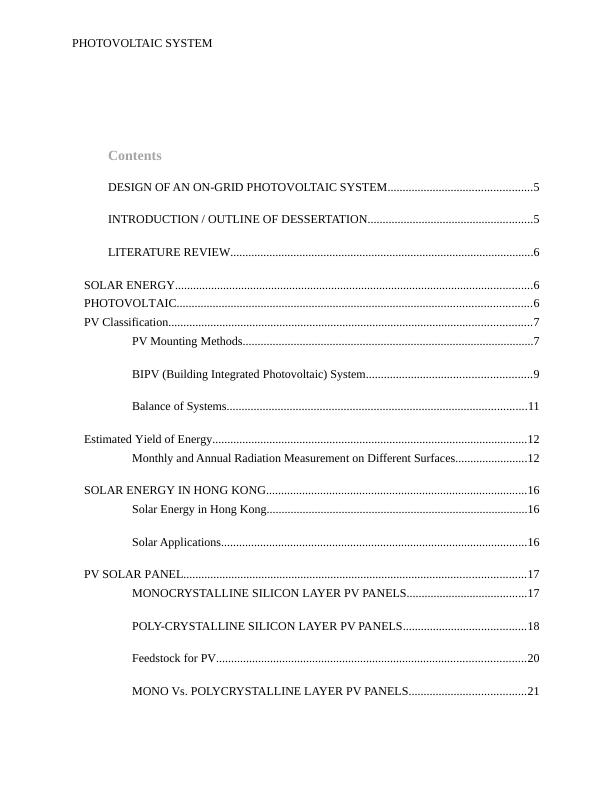
PHOTOVOLTAIC SYSTEMEnergy Policies in Hong Kong..................................................................................................25Summary....................................................................................................................................25Overall Comparison...................................................................................................25METHODOLOGY............................................................................................................25Photovoltaics..............................................................................................................................25On-Grid PV System...................................................................................................................26Types of On-Grid PV System....................................................................................................26Function.....................................................................................................................27Schematic Diagram of On-Grid Photovoltaic System...............................................................30Selection of PV Cells.................................................................................................................30Price of PV Solar Panels in Hong Kong....................................................................................30Ethics Consideration..................................................................................................................31DATA COLLECTION AND ANALYSIS.........................................................................32Energy Usage in Hong Kong.....................................................................................................33Financial Justification................................................................................................................34CONCLUSION AND FUTURE WORKS........................................................................37Conclusion.................................................................................................................................37Future Potential..........................................................................................................................38REFERENCES..................................................................................................................38
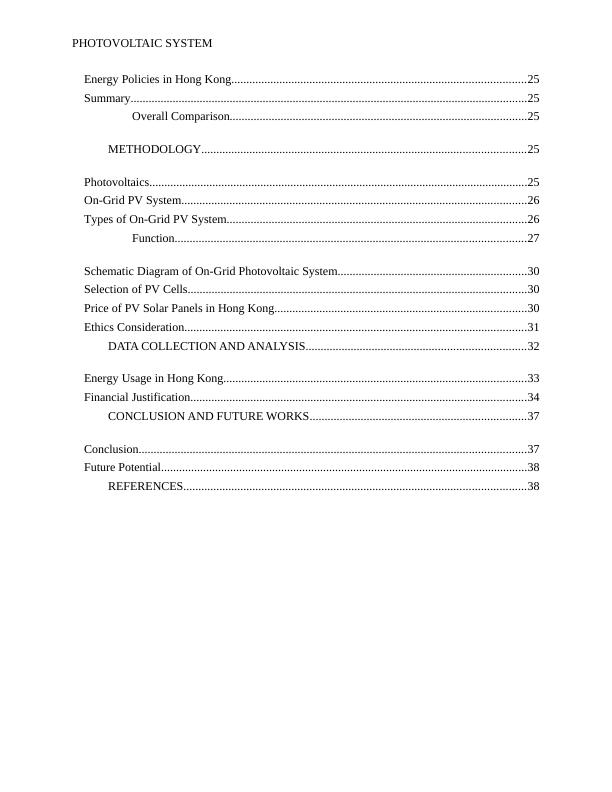
PHOTOVOLTAIC SYSTEMDESIGN OF AN ON-GRID PHOTOVOLTAIC SYSTEMINTRODUCTION / OUTLINE OF DESSERTATION Though the technology has been progressing in the world in many folds, fossil fuels stillstand as the resource for generation of electricity. Though natural and free resources are availablein every part of the world, utilization of these natural and renewable resources is still at primarystage with a little share, in the generation of electricity. However, fossil fuels are quite limitedand usage of the same has been resulting in global climate change, because of release ofgreenhouse gases into the atmosphere, from fossil fuels. The harmful effects of global climatechange are in the initial stages and if the same usage of limited resources is continued,environment damage will no doubt become hard to live in. Since the Industrial Revolutionstarted in 1750, the overall human activities have resulted and released 40% of increase of CO2atmospheric concentration that reached to 406 ppm, recorded in 2017, from 260 ppm in 1750. Ifthe same increase of CO2 concentration is continued, by 2047, the temperature of the Earthsurface will result in harmful effects over livelihoods of people, biodiversity and ecosystems,throughout the world (Census and Statistics Department, 2015). Hence, the present CO2 concentration is considered as a wakeup call, by most of thedeveloped and developing countries to reduce the usage of the fossil fuel and replace withrenewable energy resources. Eventually, the importance of solar energy, which is abundantlyavailable, throughout the surface of the Earth has been recognized. Production andmanufacturing of the solar cells or Photovoltaic cells are emphasized to absorb the solar energyand convert it into electrical energy (Cheng, 2005). On-grid Photovoltaic System is one of the
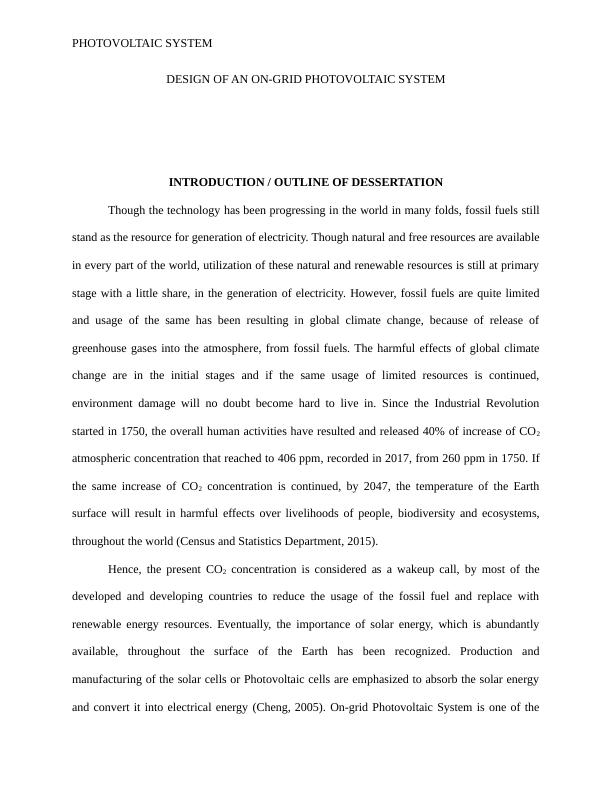
PHOTOVOLTAIC SYSTEMbest ways to arrange over the buildings and rural wider areas to maximize the utilization of thesolar energy. LITERATURE REVIEWSOLAR ENERGYSunlight stands as the largest source of energy in the world. Solar energy has the potentialof converting into the electrical energy directly with the help of several technologies. Thistechnology can be categorized as the following, fundamentally. 1.Solar Photovoltaic: Photovoltaic devices of simple solar cells are used to convertthe solar radiation into electricity directly. Development of solar cell was donesuccessfully, in the year 1975 and this technology is new relatively. But, thetechnology of Photovoltaic has been progressing drastically, from that point andstands presently as the primary form of application of solar energy (Fraunhofer,2014). 2.Solar Thermal: Solar thermal is the technology that makes use of the heat energyemitted from the solar energy from the Sun. The technology makes use of thesolar radiation by absorbing it through the solar collectors and water heating orsolar space is provided at the lower temperatures, relatively. The applications canbe scaled up by concentrating the solar radiation with the help of the parabolicmirrors to obtain higher temperatures that in turn is made use either for directgeneration of electricity through conventional heat engine or for direct heatingpurpose.
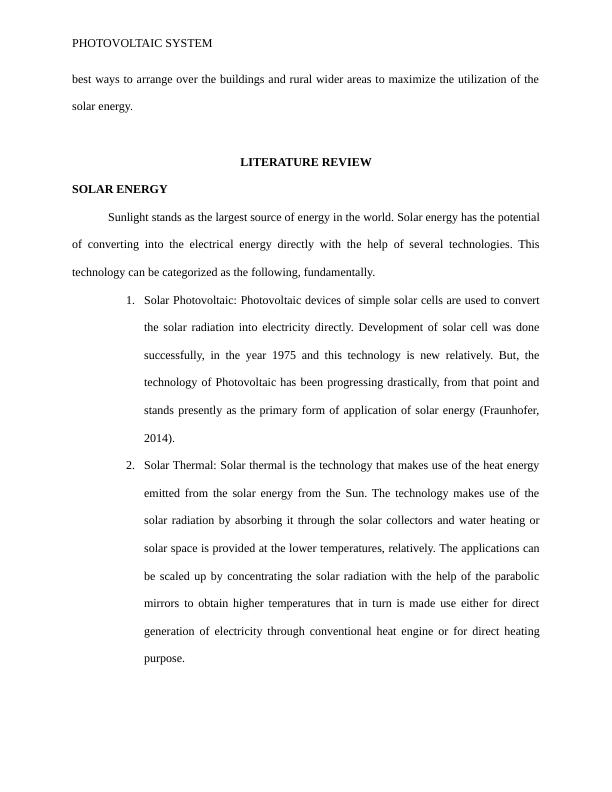
PHOTOVOLTAIC SYSTEMPHOTOVOLTAICThe solar cells or Photovoltaic devices are used to convert the light energy from thesunlight, directly. It does not need any input energy, post-installation, other than the source oflight, which is emitted for the sun only needed. Inherent modularity of this system allows the PVsystems to get installed in capacities of smaller increments, compared to the most of the othertechnologies of electrical generation (IEA, 2014). PV Classification A wider range of solar cells technologies does exist and competes with each other for themarket of terrestrial Photovoltaic devices. Some significant technologies and PV modules are asthe following. 1.Thin Film CellsThe most common type of thin film cells is amorphous modules and cells and they havethe applications more as the semitransparent modules used for consumer products usedfor the sunroofs of cars and PV power systems that includes both remote and standalonekinds. These modules and cells are comparatively lower in cost than the wafer-basedsilicon cells. However, they have a drawback of lower efficiency, which ranges from 6%to 7%, for the commercial modules. 2.Wafer-based Modules and CellsThese modules consist of the material, multi-crystalline, mono-crystalline, GaAs(Gallium Arsenide), ribbon silicon and materials of similar type. Both multi-crystallineand mono-crystalline modules yield more efficiency that ranges from 11% to 13%.Relatively higher efficiency has increased its potential of usage for commercialapplications and grabbed 83% of the solar modules market, in 1998, in Hong Kong.
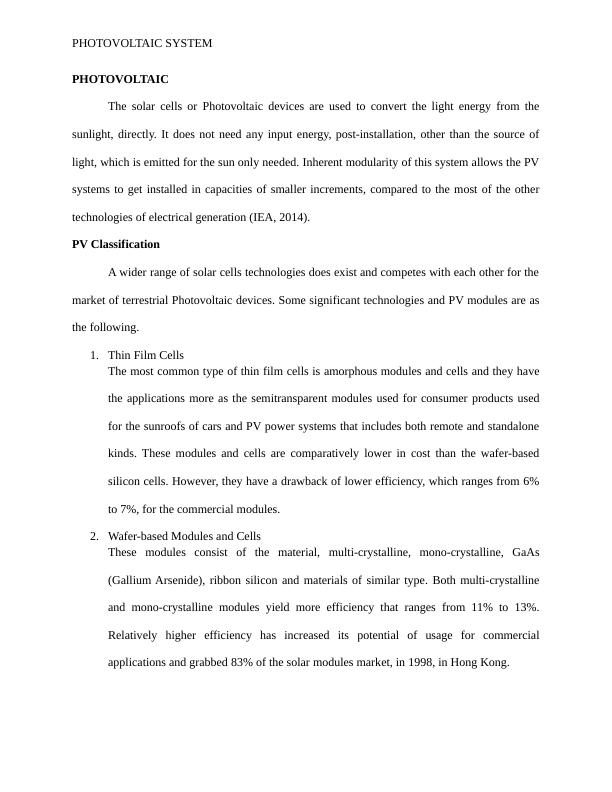
PHOTOVOLTAIC SYSTEMPV Mounting MethodsWhen wafer-based technologies are considered, manufacturing, interconnection andassembling of the individual cells are done into a module with glass-front. These modules arewell protected from dust, moisture, mechanical stress, hail, salt, etc. Basically glass should havebetter light wavelength transmission, to which the cells get responded to provide non-staining,abrasion-resistance and self cleaning surface (Peng et al, 2013). These glass surfaces are madewith tampered low-iron glass. The method has to be more considerate with spot heating, materialdegradation, capability of capturing of lights from reflection and prevention of cells or modulesmismatch. The most reliable and simplest arrangement of mounting is usually, fix flat-plate module,set in a single position. These modules are placed tilting at the angel of latitude, approximatelyso that production of power can be maximized. These plate modules are designed and developedfor the purpose of rotating about one axis or two axes, so that the module keeps moving to followthe movement of the sun, towards increasing the production of the power. So, these modules arecalled tracking flat plate collectors. The collection of solar energy can be concentrated by usingtracking concentrators, towards saving of the cost of the solar cell. Collection is done over alarge area onto an area of small size over the solar cell. However, the concentrator has thedrawback of incapability to use diffuse light, which is a strength or benefit of the flat platesystems (Saunders et al, 2008).

PHOTOVOLTAIC SYSTEMFigure: Fixed and Tilted Photovoltaic System (Li et al, 2005)BIPV (Building Integrated Photovoltaic) System The aim and objective of the BIPV system is to reduce the overall cost, through PVstructural integration into the envelope of building, so that it can provide aesthetical and novelpleasing architectural alternatives. The major factor here is the appearance, in the way of makingthe solar cells and arraying them in the overall design of the building (Li et al, 2005). The sameappearance factor is applied to the solar cell colour too. As the color of the best performancecells is opaque dark blue, the color of the cell would now matter for building architect, apartfrom the solar engineer. Though there is an option to color the solar cells, it adds up the costtremendously with additional drawback of reducing the overall efficiency of the solar cells.
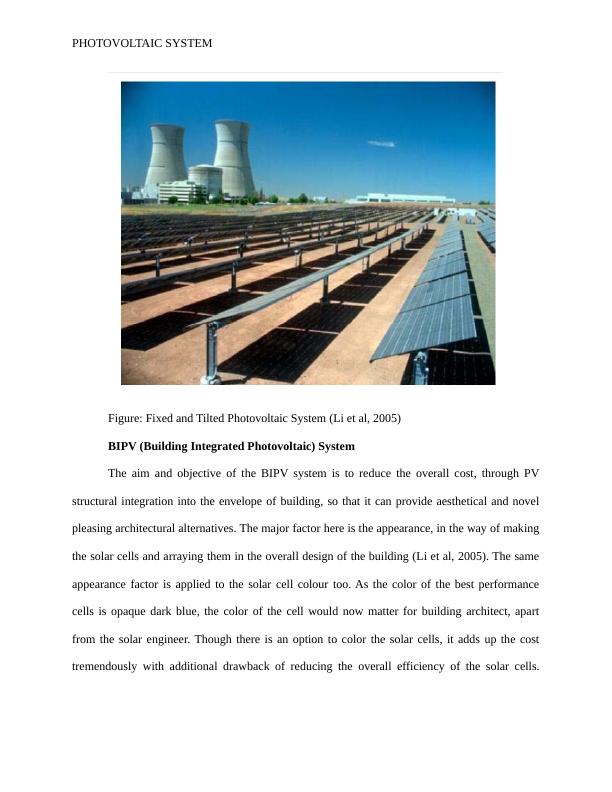
End of preview
Want to access all the pages? Upload your documents or become a member.
Related Documents
conventional photovoltaics systems Assignment PDFlg...
|18
|3480
|361
Photovoltaic Solar Power System Assignment 2022lg...
|21
|3747
|135
Study on Hybrid System with Photovoltaic and Fuel Celllg...
|18
|2508
|255
Constraints and regulations in Solarlg...
|19
|4648
|17
Paper on Methods of Solar Photovoltaic Cellslg...
|45
|10576
|59
Pw Engineering Group Assignment Reportlg...
|34
|5392
|27
